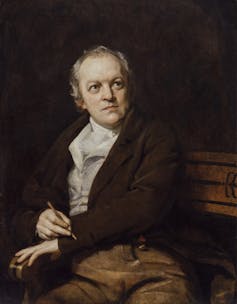This article was first published in our email newsletter Something Good, which every fortnight brings you a summary of the best things to watch, visit and read, as recommended and analysed by academic experts. Click here to receive the newsletter direct to your inbox
Here’s a winning equation for you. The creators of Game of Thrones adapting one of the most celebrated authors of Chinese science fiction, whose books are beloved by fans including Barack Obama and Mark Zuckerberg. No wonder 3 Body Problem looks set to be one of the biggest Netflix shows of the year.
Based on Liu Cixin’s Remembrance of Earth’s Past trilogy, the series begins amid China’s Cultural Revolution in the mid-1960s. But it soon moves to the present day, where several top scientists have mysteriously committed suicide. What unfolds is an alien invasion story with a twist, as scientists and officials race to protect human civilisation from the incoming Trisolarans.
Mia Chen Ma, an expert in Chinese sci-fi, has been “captivated” by the eight-part series, which is released today. She is particularly impressed by Netflix’s willingness to get stuck into the big philosophical questions at the heart of Liu’s novels. If a technologically superior alien civilisation were to invade Earth – a planet already plagued with ecological destruction and human conflict – how should we respond? Is humanity worth saving? Is saving ourselves even possible?
As our author explains, the show offers a range of answers. But ultimately, its mix of intrigue and open-ended storytelling encourages viewers to draw their own conclusions.
Left-field love stories
Lesbians have had a rough ride at the cinema. For nearly 40 years between 1930 and 1966, the Hays Code (strict censorship guides imposed on filmmakers) only allowed depictions of the “sexual perversion” of lesbianism if shown in a negative light. The film lesbians of these years (in movies such as Dracula’s Daughter, Rebecca and The Children’s Hour) were murderous, farcical, or rebels sorely in need of reform.
Thankfully, there has been change in recent times. Historical dramas like Carol (2015), Ammonite (2020) and my personal favourite, Portrait of a Lady on Fire (2019) have all shown tender love stories between women. But as touching and refreshing as these portrayals of women in love are, they’re all rather sad. So, I was cheered to read Deborah Shaw’s review of Drive-Away Dolls.
The trailer for Drive-Away Dolls.
“Odd couple” friends Jamie (Margaret Qualley) and Marian (Geraldine Viswanathan) take a road trip in a hired car. Jamie wants to visit as many lesbian bars as possible, in a quest to cheer up Marian, who has just split with her girlfriend. Unbeknownst to them, the friends are driving a car with a mysterious suitcase in the boot and soon they’re being pursued by hapless thugs. This brainchild of Ethan Coen and his wife Tricia Cooke (a queer woman herself) is a lesbian road movie that will make you laugh, rather than tugging on your heart strings.
A film that’s always managed to make me laugh and cry in equal measure is Michel Gondry’s masterpiece Eternal Sunshine of the Spotless Mind, which turned 20 this week. I’ve rewatched the movie several times in recent years, and it somehow brings out a new emotion in me with every viewing.
This week, it was the scene where Joel (Jim Carrey) and Clementine (a blue-haired Kate Winslet) meet in his memories as children that got me. Especially the moment when she steps in to protect him from the childhood bullies that he faced alone in real life.
For Jane Steventon, the film is an unflinching meditation on love and memory. And it was shockingly prescient. A movie about a man erasing the memories of an ex-lover takes on a whole new resonance in our social media age, when the photos of and posts about a previous relationship can be deleted with the touch of a button.
Broadening horizons
Despite his fame today, the artist and poet William Blake was relatively unknown in his time. This meant he couldn’t afford to travel widely, as many of his more successful contemporaries did. In fact, Blake never left Britain. But he was certainly interested in Europe. He read the works of Dante in Italian and translations of German philosophers such as Jakob Böhme and Swedish theologians like Emanual Swedenborg.
William Blake by Thomas Phillips (1807). National Portrait Gallery
So, a new exhibition at the Fitzwilliam Museum in Cambridge that shows Blake’s art and poetry alongside that of his European contemporaries feels like retroactive justice.
His beautiful hand-printed poem, Europe, and his energetic reinterpretations of ancient Greek sculptures take on new life when displayed alongside the artists who really lived and worked in these locations. The show expands Blake’s personal creative universe, reframing it as part of a shared imaginative and cultural space. That this exhibition figuratively takes Blake – and visitors – on a journey across Europe, is something very special.
Tropical Modernism: Architecture and Independence, now open at London’s V&A, showcases the legacy of tropical modernism in Ghana and India. This style of architecture was developed specifically for tropical climates, resulting in grand, elaborate structures that provide optimal ventilation and minimise solar heat gain.
Our reviewer, Adefolatomiwa Toye, who is writing a PhD on tropical modernism, was impressed. The show challenges the Eurocentric stories that are often told about these designs and spotlights the architects and labourers from India and Ghana who helped to create some of their country’s most iconic buildings.



 Vaping now more common than smoking among young people – and the risks go beyond lung and brain damage
Vaping now more common than smoking among young people – and the risks go beyond lung and brain damage  Nigerians throw naira notes around to show love: but it could land you in jail
Nigerians throw naira notes around to show love: but it could land you in jail  History for sale: what does South Africa’s struggle heritage mean after 30 years of democracy?
History for sale: what does South Africa’s struggle heritage mean after 30 years of democracy?  Ukraine war: Putin’s plan to fire up Zaporizhzhia power plant risks massive nuclear disaster
Ukraine war: Putin’s plan to fire up Zaporizhzhia power plant risks massive nuclear disaster  Family farms are fast disappearing: our research shows how young generations can take them up successfully
Family farms are fast disappearing: our research shows how young generations can take them up successfully  The politics stopping the UK from opening a youth mobility scheme with Europe
The politics stopping the UK from opening a youth mobility scheme with Europe  How breakdancing became the latest Olympic sport
How breakdancing became the latest Olympic sport  What’s the difference between ADD and ADHD?
What’s the difference between ADD and ADHD?  What kind of diner are you? 6 types of diners who avoid plant-based meat dishes
What kind of diner are you? 6 types of diners who avoid plant-based meat dishes  Half our colleagues suffer pain and discomfort from periods. But they’re still a taboo subject at work
Half our colleagues suffer pain and discomfort from periods. But they’re still a taboo subject at work 

































